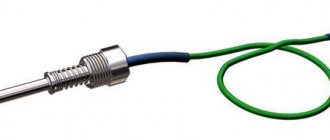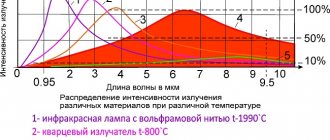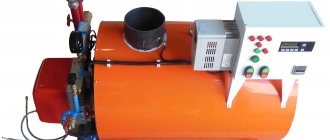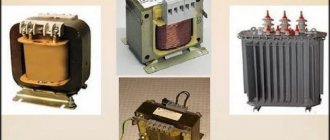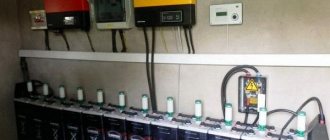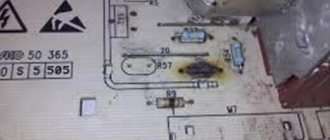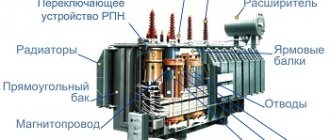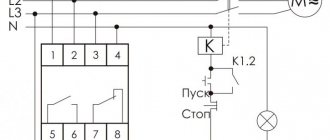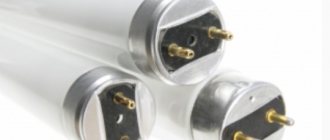How does an oil heater work?
The circuit of each oil heater is similar. The body of the heating unit is metal and consists of several sections that are hermetically joined together. The inside of the structure is filled with mineral oil, and the outside is covered with a layer of powder paint, which is very durable and resistant to mechanical damage.
The package includes:
- heating element (heating element);
- thermostat;
- heating regulator;
- wires;
- overlay panels.
The operating principle of any oil heater is the same. First, the wire is connected to the network, the heating element is heated, then, under the influence of thermal energy, the oil is heated, then the housing. Heat from the heated body is transferred to the air that comes into contact with it, it heats up and rises. According to the convection principle, cold and hot air are mixed, and its temperature rises. Some models are equipped with a fan to make the air change more intense.
Thermal energy heats the oil
Heating devices have different power levels and differ in the number of sealed parts. The room will heat up faster if the unit has more sections. At the same time, the heater is heavier and larger in size. All models are equipped with wheels with which the devices are moved, so the mobility of the heater does not depend on its size.
Oil convectors have a number of operating modes. For this purpose, switches are installed, and on some models there are touch control panels or LCD monitors, which show data on the operation of the device.
Why does the oil heater click?
Sometimes the oil cooler cracks during operation. If the device clicks when heating up, and the extraneous noise lasts no more than 3-5 minutes, then this can happen for the following reasons:
- Moisture (water vapor) has entered the sealed housing with oil. This can happen if the radiator was assembled in a damp room. When the appliance is turned off and the oil is cold, water condenses. When you turn on the device, the water heats up much faster than oil. A clicking sound is heard when boiling. When all the liquid turns into a gaseous state, the cracking stops.
- When the radiator is moved or accidentally dropped, the working fluid is shaken and mixed with air. When the device is turned on and the temperature rises, the air bubbles expand, increase in volume, and then rise up. When they burst, a clicking sound is heard. After the oil has completely warmed up, the sound disappears.
- Metal structural elements expand and crack when heated. Most often, the bimetallic switch in the thermal relay clicks. When heated, it opens, and when it cools to the required temperature, it closes again. This process is accompanied by a characteristic click.
Defects are extremely unpleasant, but there is no way to eliminate them. Such noises do not affect the functioning of the heater and therefore are not considered a defect.
If the alarming sounds do not go away after warming up, then the reason is more dangerous, since normal operation of oil radiators should be silent (excluding fan noise). This can be caused by electrical failures or defects in the casing. If the crackling noise lasts too long, the heater must be repaired. It is not recommended to try to repair the device yourself.
How to disassemble an oil heater?
Before repairing the heater, you need to determine the cause of the breakdown. To do this, you will need to disassemble the unit, although outwardly it seems that the oil heater cannot be disassembled, since it is monolithic.
Important! Before starting repairs, the device must be disconnected from the network. The structure cannot be turned on until it is fully assembled.
Disassembly procedure
There are many different models of oil heaters; there is no exact algorithm for analysis. But we can highlight general rules with the help of which the unit can be disassembled faster.
It is not difficult to disassemble an oil heater
First you need to carefully study the convector control panel. The design of a cheap oil heater is similar to an expensive one. Disassembly begins with the stage of unscrewing the bolts and removing fasteners. On some models, instead of screws, there is a plastic panel that is latched with a spring. In this case, you need to feel the latch on the panel with any wedge-shaped object (preferably made of plastic), press it harder and thereby bend it.
If the repair is being carried out for the first time, it is advisable to take a photo of the entire process. This will help to correctly reassemble the disassembled unit after repair. It is also recommended that when removing bolts and screws, lay them out in the order in which they were unscrewed. This will allow you to correctly screw them back into the radiator, in the correct sequence.
Oil heaters with a power of 1000 W
Oil heaters with a power of 1000 W are suitable as the main heating for a small room of 4-6 m2. Such a heater will cope with its task even in cold weather and will not constantly operate at full capacity. If the room already has another type of heating, then they are used to heat up to the required temperature over an area of up to 10 m2.
| Hyundai H-HO9-05-UI846 | Timberk TOR 21.1005 SLX | |
| Power adjustment | ||
| Heating power, W | 1000 | 1000 |
| Heating area, sq.m. | 10 | 15 |
| Number of sections, pcs | 5 | 5 |
| Dimensions (WxHxD), mm | 240x620x255 | 235x620x250 |
| Weight, kg | 4,2 | 4,8 |
Hyundai H-HO9-05-UI846
Beautiful and compact oil heater with a power of 1000 W and 5 sections. The radiator is stable and maneuverable thanks to a platform on 4 wheels. Temperature adjustment and power level selection (minimum/medium/maximum) are provided.
+ Pros of Hyundai H-HO9-05-UI846
- Automatic shutdown after reaching the set temperature and subsequent activation when it cools down a little.
- Built-in overheat protection.
- Compact for transportation from one room to another.
- Korean assembly is of better quality than in other Asian countries.
- Thanks to 5 sections it does not take up much space in a small room.
- Economical energy consumption - at maximum power only 1 kW.
- Does not stink or vibrate during operation.
— Cons of Hyundai H-HO9-05-UI846
- On the light-colored body, fingerprints from dirty hands and accumulated debris from the air quickly become noticeable.
- It cools down quickly, so the relay often clicks, which can be annoying at night.
- The narrow vertical body is easy to tip over if it is accidentally pushed or if a wheel catches on a fold of carpet during transport.
- Ineffective when the voltage drops below 220 V - it barely heats.
Conclusion. This oil heater is well suited for heating small spaces. Built-in overheating protection allows you to leave it on all night without fear of fire.
Timberk TOR 21.1005 SLX
Radiator in five sections with electronic control, allowing you to accurately set the temperature. Maximum power 1000 W. For adjustment, there is a thermostat and a rotary switch, as well as two toggle switches for power control.
+ Pros Timberk TOR 21.1005 SLX
- At the top of the case there is a recess for a handle, and at the bottom, on the opposite end of the case, there are wheels - this makes it easy to move to another room even when the heater is on.
- Multifaceted thermostat adjustment - selecting the temperature and the speed at which it is reached.
- Completely silent operation - you can’t hear the oil bubbling.
- Automatic shutdown when the temperature rises.
- The weight of 4.5 kg is convenient for transporting the heating device to the dacha.
- Doesn't burn oxygen.
— Cons of Timberk TOR 21.1005 SLX
The instructions supplied with it are universal (for many models of heaters from this manufacturer), and there is no information about controlling two toggle switches - you have to figure it out through experimentation. You can get burned if you accidentally touch a heated heater - it is important to place it so that a child cannot approach it. Some users, a year after purchase, experienced a leak in one of the oil sections. At first, there may be a plastic smell when heating. It comes with the wheels unscrewed - you need to figure out how to attach them.
Conclusion. This heater is suitable for a small bathroom. Its body, including electronics, is well protected from splashes, and the platform is more stable thanks to two wheels on one side and a support stand on the other. It is perfect for warming up the room when bathing or drying washed clothes.
Advantages and disadvantages
These devices are completely safe. They have no exposed heating elements and therefore accidental fires are virtually nil. Such heaters were invented quite a long time ago and the principle of operation, as well as their design, have not changed. But modern models have many functional additions, for example:
- Thermostats that allow a smooth transition to different heating modes.
- Sensors for switching off the device when it overheats.
- Light indicators.
- Operating mode switches to set the required power in order to save money.
- Timers for turning the device on and off at a certain time.
- Built-in humidifiers.
- Built-in fans to increase the speed of heating the room.
Oil radiator devices are durable in operation and can operate for up to three days without being turned off.
Their disadvantages (which can easily be transformed into advantages) include:
- It takes a long time to warm up the entire room, but with a built-in fan, the heating process increases significantly, and the room heats up much faster.
- They are quite heavy, but they have good mobility due to the presence of special wheels for movement.
Popular models of oil heaters
Let's look at the most popular heater models.
Ballu BOH/CL-09
Consists of three modules, operates in three modes with power from 600 to 1500 W. Can heat a room of twenty square meters. Equipped with a thermostat to maintain the set temperature for a certain time. For ease of movement it is equipped with wheels. Filled with mineral oil. Refers to environmentally friendly products.
The cost of such a device is from 2 to 4.5 thousand rubles.
Delonghi KH 770920 HOR
The unit is assembled from nine sections. It has cells to maintain the desired temperature, due to this it does not overheat. The device can heat a room up to 60 square meters. meters, has a thermostat, operates with a power of up to 2500 W. It has wheels that can be folded and a handle that can be moved freely.
The cost of this model varies from 5 to 6.5 thousand rubles.
Oil heater Delonghi KH 770920 HOR
Timberk TOR 21.1005 SLX
The structure consists of 5 sections. Capable of heating a room of 15 square meters. meters, the power of the unit does not exceed 100 W. Thanks to its small size, it is convenient to carry. Includes a folding handle, a power cord about 2 m long and wheels. An overheating protection system and indicator are installed.
You can buy such a model for 1,500 - 2,600 rubles.
General Climate NY18LA
Operates with a power of up to 1800 W, this allows the device to heat up to 18 square meters. meters. The model is controlled mechanically, has an anti-freeze function and a light indicator.
The cost of such a device is reasonable, ranging from 1,900 to 4,000 rubles.
Vitek VT-2122 GY
The thermostat of this unit is designed to heat a room up to 25 m2. The heater is floor-standing and can operate in different modes, in which the power can be set from 800 W to 2000 W. This is the best option for a small apartment. The heating temperature can be adjusted and is equipped with a light indicator.
The cost of such a unit ranges from 2,600 to 4,100 rubles.
POLARIS CR0920B
This device has a stylish design. Operates with a power of up to 2000 W, consists of nine modules. There is a power adjustment function. The package includes wheels for movement, as well as a folding handle. The area of the heated room is up to 20 square meters. meters. It is possible to connect the fireplace effect. It is also equipped with a special device that is built-in for winding the cord. Costs up to 3000 rubles.
SUPRA ORS-05-P2
A very compact unit, easy to move, easy to operate. The power regulator has three levels and operates with a power of up to 1000 W. Consists of five modules. Mechanically controlled, power can be adjusted.
Refers to budget options: its cost ranges from 1,800 to 2,900 rubles.
Electrolux EOH/M-3105
The thermostat of this model was developed using highly environmentally friendly oil HD-300, which was first subjected to additional purification in several levels. This unit has three operating modes with different powers (from 400 to 1000 W). The largest area of the heated room is 15 square meters. meters.
It has additional sensors to monitor the safety of use: overheating, tipping over, and is also equipped with a light indicator of the device status (shows on/off) and a special dust protection system. The cost is 2,600 - 5,600 rubles.
Ballu BOH/CL-09
The design consists of nine modules, mechanical control, operates in three modes, which allow you to change the power from 800 to 2000 W. It is a floor-standing device. Designed for a room up to 25 square meters. meters. To move the device there are wheels and a special handle.
You can buy such a model for 2,100 - 4,600 rubles.
Electrolux EOH/M-3221
The unit includes 11 modules, has a steel body, and the maximum possible power is 2200 W. Designed for use on 28 - 30 sq. meters. Equipped with a tip-over protection system, as well as an adjustable thermostat that allows you to set the desired temperature.
The package includes a handle for moving, a power cord, a built-in cable storage compartment and wheels that fold. High characteristics provide a cost from 3,400 to 7,700 rubles.
Oil heaters are very widely used in apartments, houses and office spaces, as they are very convenient to use and have high heat output. Therefore, it is recommended to purchase such a device in advance, before the cold weather begins.
Criterias of choice
To choose the right equipment, you need to decide in advance on the desired characteristics.
Power
Please note that the higher the indicator, the more electricity the equipment consumes. The calculation is made based on the tasks assigned to the battery and the area.
According to this characteristic, all devices are divided into three categories:
- low-power – 0.5-1 kW;
- average power – 1-2.5 kW;
- high-power – 2.5-3 kW.
Operating principle and design of an oil heater
An oil heater is nothing more than a metal structure in the form of a housing, inside of which there is a container with special mineral oil and a heating device. Outwardly, they resemble ordinary batteries, due to the presence of many divisions. The operating principle of devices of this kind is as follows:
- when the heater is turned on, the heating element starts to work, heating the oil;
- boiling oil gradually gives off its heat to the metal body, which in turn promotes the convection processes of warm air.
radiator configurations,
Oil heaters are usually used to warm up one room, but due to the ease of their movement, one powerful radiator can easily maintain an acceptable air temperature for the entire living area. In addition, they are quite mobile and will occupy a convenient location even in the smallest room. In almost all models of oil radiators, there are several operating modes that help correct the intensity of air heating.
For safety reasons, such devices are equipped with a protective function against excessive overheating. Saving electrical energy is achieved through a built-in timer, which turns off the heater when an acceptable temperature in the room is reached, and after a certain time has passed and the room has cooled down, turns it on again. The power cord twists automatically.
Recommendations for caring for oil heaters
Caring for them is quite simple, and if you follow these recommendations, the devices will last a very long time:
- Their surface cannot be cleaned with abrasive substances.
- Wipe the top of the appliances with a dry soft cloth (when switched off and cooled down).
- Do not dry clothes on the radiator itself, so as not to cause it to overheat (use only frames designed for this purpose).
- Do not fold the power cord on the hot surface of the device (for this purpose, most models have special recesses for storing them).
- Make sure that the device is in a vertical position.
- Place such devices away from easily fusible products.
Knowing how a household oil heater works, the features of its operation, taking into account such nuances as the power of the device corresponding to the area of the heated room, you can always choose the most suitable model for your home. You just need to remember that the cost of the device will directly depend on the number of additional functions.
Installation methods
Oil heaters have several modifications and installation methods:
- Floor radiators. The most common and popular type of oil units. For ease of movement, the device is equipped with special wheels. As a rule, such devices are universal in terms of installation type, since they allow the use of not only floor mounting, but also wall mounting.
- Wall radiators. Thanks to the brackets included with the heaters, they can be hung on the wall. Compared to floor-mounted structures, devices of this modification are not as powerful and have low heat transfer.
- Baseboard heaters. This design of the device is intended for wall mounting. The radiator is placed at the bottom of the wall, which ensures good air circulation. It is used indoors as a full-fledged heat source and is an alternative to central heating.
Oil heaters can also be:
- With thermostat. In order to ensure long-term operation of the device and reduce energy consumption, electronic thermostats are built into the radiators, which maintain the set temperature regime and eliminate the possibility of changes.
- With a fan. To quickly heat the air, the devices are equipped with built-in fans that redistribute the flow of air masses. The only disadvantage inherent in these varieties is the noisy operation of the fan.
Safety precautions and operating features
If you bought such a heating device, then first of all you need to read the operating instructions. These devices operate on a 220V power supply, which is dangerous to human health and life.
To ensure safety when operating heaters of this type, the following rules must be observed:
- Do not place the device closer than half a meter from the walls, since the thermal relay installed inside will constantly turn it off.
- Heaters should not be used in rooms with high humidity levels (bathrooms).
- You cannot keep a radiator in an unheated room in winter (on a loggia, balcony, veranda, etc.).
- It is prohibited to use the device as a dryer without special devices, or to cover it with a cloth, since overheating may result in oil leakage.
- It is important that the cable does not come into contact with hot sections, since the braiding (insulation) may melt.
- The device should be kept exclusively in a vertical position, since the oil in the housing is not filled to the top and when the heater is laid on its side, the heating element is exposed. This can contribute to overheating of the liquid and depressurization.
- The device cannot be turned on if the overheating sensor is not working.
- Do not move the device around the room by the cord; a broken cord may cause a short circuit.
How much electricity does an oil heater consume?
The main criterion by which you can calculate how many kilowatts an oil heater consumes is the power consumption of the device. The higher this indicator, the greater the energy consumption of the device. But the equipment does not always work at full capacity. How much a heating device consumes directly depends on the mode in which it operates.
If you take an oil heater whose electricity consumption is 2 kW, then at full power it will consume 2000 W. The thermostat periodically turns off the heating elements, so the operating time will be no more than 8 hours a day. The consumption will be about 16 kW per day. When you multiply this number by the current tariff (price of 1 kW), you get the cost of consumed electricity for 24 hours of operation. Based on these calculations, monthly consumption is calculated.
It is possible to calculate the cost of heating for a month or for the entire heating period if you know the power characteristic of each heating mode. Most often, the energy consumption of an oil heater is much lower than the maximum values due to the operation of the thermostat, which turns off the device when the desired temperature is reached.
Main characteristics of modern oil radiators
Experts highlight the following technical characteristics that distinguish modern oil radiators from other types of heating devices.
Safety shutdown
When choosing a portable oil heater, make sure it has safety shut-off features to minimize the risk of fire. Options should include overheat protection and rollover protection. Some models also offer freeze protection to ensure the oil doesn't freeze if it gets too cold when stored in freezing temperatures for long periods of time.
Manufacturer's warranty
Be sure to look for an oil heater that is backed by a solid warranty from a reputable company. There are many heater manufacturers and sellers out there, and not all heaters are designed to be super reliable and long lasting. You don't want to invest in a new heater only to have it break shortly after purchase and find that you have no way to replace it.
Incremental thermostat
While all oil heaters come with adjustable thermostats, those with gradual changes are the most customizable, allowing you to increase or decrease the heater's temperature by one degree. Some oil heaters offer very limited temperature settings, making it difficult to achieve the desired level of heat in a room.
Multiple heat settings
A good oil heater will allow you to customize the amount of heat produced depending on your needs or comfort level. Look for a heater that offers at least two or three heat settings ranging from low to high.
Other Considerations
Heat capacity
Consider the size of the space in which you will be using the oil heater. Large rooms require 900 to 1,500 watts of heating power, while small offices, bathrooms and bedrooms can be adequately heated with a 300 to 500 watt heater. If you are going to heat a small room, then a larger and more expensive heater is not necessary.
Mobility
If you plan to use your oil heater in different areas of your home or office, ease of portability is key. Some oil heaters are bulky and much heavier than other models. Does the device have wheels for easy transportation?
How to calculate the required heater power
A very important point when choosing an oil heater is its power, since it is selected specifically for the size of the room that will be heated with its help. First of all, you need to learn one simple rule that is suitable for calculating power for all heating devices, namely: for heating every 10 square meters. m of room requires 1 kW of energy, which is emitted by the device. But this condition is suitable for a living space, the ceilings of which are standard - 2.75 m. If the height is different, you can calculate the power using the following algorithm:
- First, calculate the area of the room by multiplying the length and width.
- Then determine the volume of the room by multiplying the resulting area by the height of the room.
- Divide the volume by 25 (division is made by the number 25, implying that 1 kW of generated energy is required per 25 m3.
- The result obtained will be the number of kW that the device needs to heat a particular room.
If we summarize all of the above, then for a room of about 20 square meters. m, an oil heater with a power of 1.5 kW is quite suitable; if the room is larger, then the power will need to be increased accordingly. Radiators of this type with a power of up to 2.5 kW are presented in a large assortment on the domestic market, and choosing equipment with various additional functions is not difficult.
Important technical features of an oil heating radiator
All of these heaters may differ in power, so when choosing a radiator for your home, you should take into account the area of the room to be heated. To heat 10 sq. m will require 1 kW of energy (if this is a room with a standard height of 2.75 m).
Wall-mounted oil radiators - more economical models
In the description of the device, you should pay attention to the following characteristics:
- power. Oil radiators are characterized by a range of 0.5-3.0 kW, but even high-power devices cannot replace central heating;
- protection from moisture. This parameter is displayed with special markings: IP20 - no protection, IP24 - protection against splashing water, IP21 - protection against drops;
- thermal insulation coefficient: up to 0.9 - device for insulated houses, up to 2 - for standard rooms, up to 3 - for houses with single brickwork, up to 4 - for wooden houses and buildings without thermal insulation.
Mobile heaters can be used to warm up several rooms; they are safe to install in children’s rooms - the body heats up weakly (average temperature is about 60 degrees) and cannot burn.
Important! The distance between the heater and flammable objects must be greater than 90 cm.
Heater with clothes dryer
Many radiators can operate in several user-adjustable modes. They are quite safe and can be left to work unattended. There are devices equipped with air humidifiers, remote controls, and electronic timers. These functions simplify the use of the device, but also significantly affect its cost.


